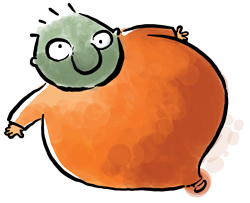Most writers write
They sit down and they write.
And some smart ones outline.
But even the outline gives us clues about bloating
It shows you how your article can go well past the original intent and into puffy-land. And you don't even have to look at the words in the outline. The bloat is visually apparent. Just look at your article outline and see how many lines you have in them.
If you've got a ton of lines, then you're almost always headed for a bloated article.
Let's take an example or two:
_____________________________________________
Cooking – Keeping the kitchen clean
“First 50 Words”
Why to keep your kitchen clean
How to avoid dirty dishes to accumulate
How to clean your kitchen
What to avoid when cleaning your kitchen
How to find the right tools to clean your kitchen
Where to store dirty dishes
When to start cleaning
What to do if your kitchen drowns in dirty dishes
Examples
Cleaning the kitchen takes too much time
Not cleaning your dishes immediately
Summary
Sandwich / Next Step
_____________________________________________
Example 2: On pelicans
What are pelicans?
Where do pelicans live?
Why do they live there?
How long do pelicans live?
What do they eat?
How do they eat with that long beak?
Do they sleep?
How do they sleep?
Why do they have a long beak?
Do they know they have a long beak?
Can pelicans fly?
How can I get a pelican as a pet?
Can you pet them?
Do they bite?
Do they like people?
What other animals are their friends?
How do they talk to each other?
Summary
_____________________________________________
Now look at the outlines above. You can tell it's a lot of information to cover
And invariably a line in your outline will lead to a paragraph or two, maybe even three, in your article. So if you have 15-20 lines in your outline, that's about 30-45 paragraphs that you have to grapple with.
And of course you're panicking now
And the way we panic is to cut back dramatically. So instead of 20 lines in our outline, we try to write three or four. And that's too few lines to have in an outline. So what's the correct number of lines to have in an outline?
As you'd expect there is no strict formula
But what you're trying to get in your outline is the critical whats, whys, hows—and maybe the when, where (if needed). You're also getting the objections in. The summary may be important. And then you're moving the reader on to the next step.
So if you randomly threw a topic at me, like “leadership”, for instance…
I'd come up with a reasonably interesting outline based on a few critical elements.
_____________________________________________
Topic or Sub-topic = Leadership
Outline:
“First 50 Words”
What is leadership?
Why is leadership important?
How to recognise if your organisation has the right leadership qualities.
But why can't we just have a democratic set up instead of leaders and followers?
What are the three common mistakes of leadership?
Summary
Sandwich/Next step.
Three minutes and thirty seconds.
Let's try another very open-ended topic
Topic or sub-topic: Career Development
“First 50 Words”
What is career development?
What is the importance of career development?
When should one start? And how long should you go?
Who pays for career development? You or your boss?
Examples/case studies of how career development helped
Career development courses and where to find them.
Summary
Sandwich
Next step.
And what you quickly realise is that you're thinking too much, which leads to bloat
Outlines don't require an enormous amount of thought. Whether it's pelicans you're writing about or geo-spatial awareness, the outline is pretty much the same. I still need to know the core answers. And yes, once you've covered the how, what, why, when, where, I still need something in the middle of the article—just to spike the interest and so you put in an objection. And yes, you can do it in five minutes or less.
But surely you have to think things through
No you don't. You'll find that for the most part, the thinking is slowing you down and not really creating any greater value to the article's contents. When you're writing the article, you will find that a question like “Why do pelicans feast on….” will bring up a ton of detail anyway. Trying to think of the details at outline stage is often a waste of time.
That's not as if to say you can't add in minor ideas into your outline. Sometimes you think of something that you may not remember later. It may not be part of the “formula” outline, and you want to make sure you get it in. Well do it. And even if you get past the outline stage, and find something missing when writing the article, you can always add it. But spare yourself the agony of thinking out every outline in the greatest details.
And look.
Look at your outline—really look!
If it's bloating, the outline expands and keeps expanding. That's a sign of sure puffiness. It's time to cut back and keep it to the core elements.
The outline is, after all just an outline.
Top Selling Products Under $50
1) Testimonial Secrets: Powerful Techniques to Get Better Clients-And Sales
2) Story Telling Series: How to suck your audience right in, in a matter of seconds
3) Sales Pages: How To Write Benefits and Bullets That Speed Up Sales
4) Article Writing: How To Speed Up Article Writing With Simple Outlines
5) Visual Basics: How Visuals Help Increase Sales Conversion On Your Website
6) Design Clarity: How to put sanity into your design with some really simple tweaks
7) Chaos Planning: How ‘Irregular' Folks Get Things Done
1) Black Belt Presentation Series: How to completely control the room—without turning anyone off?
2) New! Online Membership Sites: How To Build A Powerful, Community-Driven Membership Website


Leave a Reply